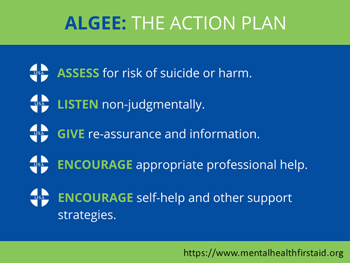More than Just a Bystander: Managing a Mental Health Crisis
by Mitchell Gullickson
March 2023
If there's been one medical topic surging in the news other than COVID-19 – it's one that is often related to mental distress. According to America's Health Rankings, North Dakotans don't often report feeling mental distress themselves. However, this doesn't mean they won't encounter someone who is experiencing distress – like someone so distressed they are considering taking their own life. Fortunately, just like first aid for individuals suffering from a broken leg or performing CPR for a heart attack, there are steps to support others in times of crisis. Mental Health First Aid (MHFA) is an organization that has created specific training for situations such as this. The organization recommends using their four-step action plan to offer aid. The plan has four simple steps which can be remembered using the acronym, ALGEE. The acronym is pronounced like the algae responsible for plaguing our lakes with the lovely green color every summer, but, of course, is spelled differently.
 The
first letter of the acronym,
“A”, stands for
assess. Assess means to take in the surroundings and the
situation. For the bystander, this means they will first
assess their own chances of being harmed by the person in
distress. Next comes checking on the safety of the
individual in distress. Although it might be an
uncomfortable question to ask, experts recommend
questioning someone directly by asking, “Are
you planning to take your own life?” This
serves as a quick and important way to offer necessary
assistance. If the answer is yes, the bystander should
call 9-1-1 and stay with the individual until assistance
arrives.
The
first letter of the acronym,
“A”, stands for
assess. Assess means to take in the surroundings and the
situation. For the bystander, this means they will first
assess their own chances of being harmed by the person in
distress. Next comes checking on the safety of the
individual in distress. Although it might be an
uncomfortable question to ask, experts recommend
questioning someone directly by asking, “Are
you planning to take your own life?” This
serves as a quick and important way to offer necessary
assistance. If the answer is yes, the bystander should
call 9-1-1 and stay with the individual until assistance
arrives.
If the answer is no, then the bystander can move to the next letter in the acronym, “L”, which stands for listening. Sometimes the best assistance for someone in a crisis is to simply listen. Experts have suggested that it's important to keep listening even in prolonged periods of silence. Silence allows the distressed individual to reflect and process their emotions. Experts also say part of listening means the bystander withholds any personal opinions about what should or should not be done. What a bystander might presume as helpful could have the opposite effect, so just being present and listening until trained personnel arrive offers the best help. The age-old adage, “you have two ears and one mouth for a reason” continues to ring true.
Following “A” and “L” comes “G”, and this stands for giving. Give an ear to listen. Give a shoulder to cry upon. Again, experts demonstrate that the greatest demonstration of support a bystander can provide to someone in crisis is giving of their presence. Although experts emphasize the importance of listening, simple phrases can be offered to fit the situation. Simply stating, “I can't imagine how difficult this must be. I am here to listen if you want to talk. I want what is best for you.” MHFA leaders share that statements such as this allow the individual in crisis to be in the driver's seat, not only allowing them to decide how much they wish to share, but to also give them the sense they are valued and supported.
Rounding out the acronym is the double “E”: encourage professional help and encourage other support. While some bystanders may feel perfectly capable of managing another individual's personal crisis on their own, it's important for them to recognize their own limitations. Professional help is often found in the form of first responders, nursing staff, primary care providers, psychologists, or psychiatrists who tend to be better equipped to help the individual in crisis. Part of the final “E” is engaging in a warm handoff. An action in which the bystander ensures the distressed individual gets directly placed in the care of a professional. In addition to providing important details to those assuming care, the warm handoff also exemplifies the commitment to giving the individual in crisis a sense of security and safety.
Small communities like Mayville already do a phenomenal job of looking out for one another. Hopefully, MHFA's ALGEE can be a helpful tool for the Mayville community and surrounding area if a bystander encounters another community member who could benefit from listening, giving, and encouragement. Bystanders should remember that it's okay to feel uncomfortable in these situations. It's not about being perfect or stringing together the perfect phrase, rather it's about showing up and lending a helping hand to an individual in need. A bystander's courage may be the difference between life and death.
This article also appeared in the February 2023 issue of the Traill County Tribune.
About the Author
 Mitchell Gullickson is a third-year medical
student at the University of North Dakota School of
Medicine & Health Sciences. who is participating in the
TRHE program, Targeted Rural Health Education. The
program teaches student doctors the importance of rural
newspapers as partners in providing community health
education. As a future rural healthcare leader,
Gullickson has written this column to provide health
information for North Dakota rural communities. The
information is not for diagnosis or treatment and should
not be used in place of previous medical advice provided
by a licensed practitioner.
Mitchell Gullickson is a third-year medical
student at the University of North Dakota School of
Medicine & Health Sciences. who is participating in the
TRHE program, Targeted Rural Health Education. The
program teaches student doctors the importance of rural
newspapers as partners in providing community health
education. As a future rural healthcare leader,
Gullickson has written this column to provide health
information for North Dakota rural communities. The
information is not for diagnosis or treatment and should
not be used in place of previous medical advice provided
by a licensed practitioner.
